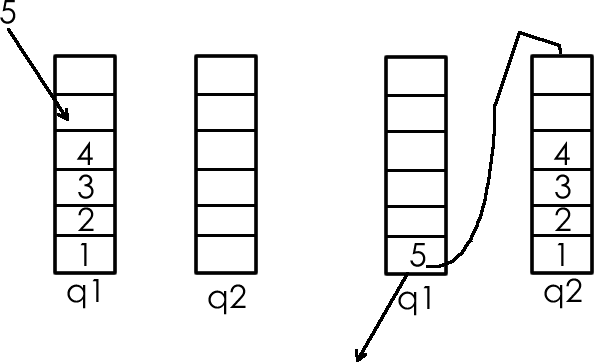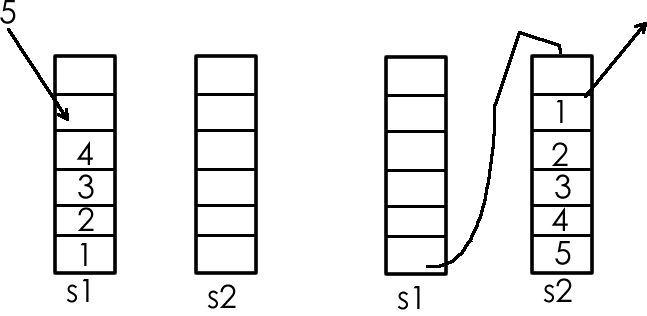使用两个队列实现栈、两个栈实现队列
介绍
队列和栈是编程中非常经典并且使用的两个数据结构:
- 队列:先入先出
- 栈:先入后出
队列和栈的互操作主要考察对两个数据结构的认识
使用两个队列实现栈
假设现有队列q1和q2,要通过q1,q2来构建数据的先入后出
栈每次pop的都是最后一次push的值,所以可以在pop的时候将原有值都压入另一个队列,
直到最后一个元素时直接弹出
所以这样的话在push的时候就必须将元素进队到有值的那个队列,大致的逻辑图就是这样:
假如当前q1有值[4,3,2,1],那么压入5的时候就会压入到q1
然后在pop的时候从q1里面依次将[4,3,2,1]压入到q2,直至最后一个元素5的时候直接返回即可
所以:
- push的时候将输入压入已有值的队列
- pop的时候将已有值的队列出队到另一个队列中,直达最后一个元素进行返回
看代码:1
2
3
4
5
6
7
8
9
10
11
12
13
14
15
16
17
18
19
20
21
22
23
24
25
26
27
28
29
30
31
32
33
34
35
36
37
38
39
40
41
42
43
44
45
46
47private Queue<Integer> queue1,queue2;
public Queue2Stack()
{
this.queue1=new LinkedList<Integer>();
this.queue2=new LinkedList<Integer>();
}
/**
* 压入栈的时候 只需要向有数据的队列进行压入即可
* 这样可以保证一个队列有值,另一个队列为空
* @param a
*/
public void push(int a)
{
if(this.queue1.size()==0)
this.queue2.add(a);
else
this.queue1.add(a);
}
/**
* 取数据的时候,有值对队列一直向空队列进行值的压入
* 直到最后一个值 进行弹出即可
* @return
*/
public int pop()
{
if(this.queue1.size()==0)
return pop(this.queue2,this.queue1);
else
return pop(this.queue1,this.queue2);
}
private int pop(Queue<Integer> normQueue,Queue<Integer> emptyQueue)
{
if(normQueue.size()==0)
return -1;
while(normQueue.size()!=1)
{
emptyQueue.add(normQueue.poll());
}
return normQueue.poll();
}
看下测试代码:1
2
3
4
5
6
7
8
9
10
11
12public static void main(String[] args)
{
Queue2Stack queue2Stack=new Queue2Stack();
queue2Stack.push(1);
queue2Stack.push(4);
queue2Stack.push(5);
System.out.println(queue2Stack.pop());
System.out.println(queue2Stack.pop());
System.out.println(queue2Stack.pop());
}
输出为:
5
4
1
两个栈实现队列
根据栈实现队里相对来说更加简单一点
现有栈s1,s2,如果现将输入压入s1,然后s1出栈再压入s2,此时可以发现s2如果再出栈的话就是队列的顺序了,看图
假如见当前数据入队到s1 [4,3,2,1],此时入队5的时候继续入s1 [5,4,3,2,1]
再出队的时候判断s2中是否有值,如果有直接pop得值就是出队的值,否则遍历s1出栈 然后入栈到s2 [1,2,3,4,5]
再从s2进行pop即可
所以:
- enQueue:总是见数据入队到s1
- deQueue:先判断s2是否有值,如果有直接pop,否则将s1的数据全部压入到s2 再从s2进行pop
代码:1
2
3
4
5
6
7
8
9
10
11
12
13
14
15
16
17
18
19
20
21
22
23
24
25
26
27
28
29
30
31
32
33
34
35
36
37private Stack<Integer> stack1,stack2;
public Stack2Queue()
{
this.stack1=new Stack<Integer>();
this.stack2=new Stack<Integer>();
}
/**
* 入队 直接压入s1即可
* @param a
*/
public void enQueue(int a)
{
this.stack1.push(a);
}
/**
* 出队 先判断s2是否有值,如果没有,现将s1的值压入s2,再返回
* @return
*/
public int deQueue(){
if(stack2.isEmpty())
{
while(!stack1.isEmpty())
{
stack2.push(stack1.pop());
}
}
return stack2.pop();
}
看下测试1
2
3
4
5
6
7
8
9
10
11public static void main(String[] args)
{
Stack2Queue test=new Stack2Queue();
test.enQueue(1);
test.enQueue(4);
test.enQueue(5);
System.out.println(test.deQueue());
System.out.println(test.deQueue());
System.out.println(test.deQueue());
}
输出结果为:
1
4
5
本作品采用[知识共享署名-非商业性使用-相同方式共享 2.5]中国大陆许可协议进行许可,我的博客欢迎复制共享,但在同时,希望保留我的署名权

